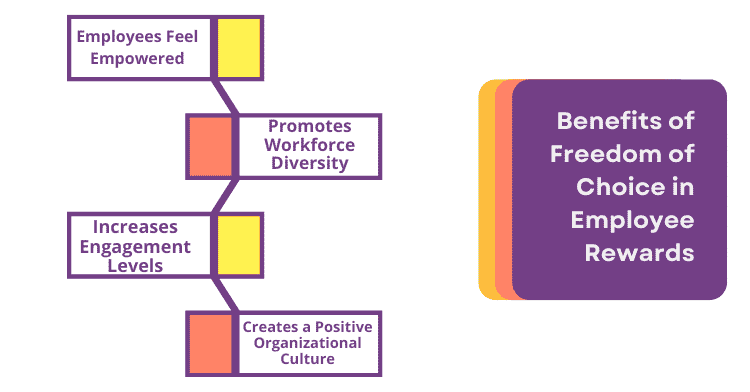1. Freedom of choice enhances employee motivation: Allowing employees to choose their rewards empowers them, making them feel valued and more motivated to achieve their goals.
2. Promotes diversity and inclusiveness: A rewards program that offers choices supports individuality, fostering a more inclusive workplace where employees feel comfortable with their diverse backgrounds and preferences.
3. Improves engagement and performance: When employees can select rewards that align with their personal preferences, their interest in the rewards program increases, leading to higher engagement and better performance.
4. Creates a positive organizational culture: Offering choice in rewards enhances employee satisfaction and improves the organization’s culture, brand value, and retention.
Organizations must implement effective employee recognition and rewards programs to keep employees engaged and motivated. Given their importance, organizations need to focus on the crucial aspects for the success of employee rewards programs.
One such factor is the choice of rewards for the program.
The common mistake that organizations make is to rely on popular options and what has worked well in the past.

It is standard for organizations to choose popular items such as iPods, gift cards of top brands, high-end watches, or company-branded merchandise as employee rewards.
Sadly, this may not work if organizations give all employees the same rewards.
The ‘all-size-fits-all’ strategy; may backfire as employees might feel disinclined to receive the same reward that their coworkers might have received previously.

It might make the rewards seem more formal than a sincere attempt to recognize employees’ hard work and dedication.
After all, not everyone might be keen to get the same kind of item as a reward.
Most importantly, it does not consider the employees’ individual preferences.
It can make them feel that their employers are either unaware or not interested in knowing about their preferences.

Hence, simply using popular reward items or what has worked in the past may make the program ineffective.
It can even leave the employees feeling disappointed with the overall program.
It might lower their motivation levels, contrary to the objectives of such employee reward programs.

To make their rewards program genuinely effective, organizations need to enable employees to choose their rewards.
Those organizations that have already implemented this strategy are getting great results from their programs.
They can set a budget for each award and provide a reasonable number of meaningful options for that budget range.

An employee rewards portal with a catalog of items of different values is the easiest way to implement this strategy.
These options could be various physical items such as electronics, lifestyle products, or experiences.
Proper logistics processes should support the rewards portal in delivering items to employees.

A simpler option is to have a catalog of gift vouchers of different brands and denominations in the employee rewards portal.
So, individual employees can choose the items or brands of vouchers based on their personal preferences, giving them complete freedom of choice.
Organizations need to constantly seek new and better ways to keep their employee reward programs exciting and interesting.
Hence, allowing employees to decide on the reward item they receive effectively ensures this.
Such a strategy benefits the organizations in many ways, as discussed below:


Granting the employees the freedom to choose their reward gives them a sense of empowerment.
They are likely to feel extra motivated to be considered worthy of the reward and to receive the reward of their choice.

As employees get a chance to choose the reward based on their preferences, their sense of individuality gets a boost.
They feel more secure about being different from their co-workers, which helps promote workforce diversity.
So, employees can feel comfortable and confident about their different backgrounds, beliefs, and preferences as members of the same workforce.

Being able to choose their rewards based on their personal preferences, creates additional interest among the employees.
Hence, this increases their level of engagement as they strive to perform better and work towards getting the desired reward.

The organizational culture improves significantly as employees become more engaged and satisfied with the rewards policy.
This impacts the employee goodwill and employer brand value of the organization positively. It also enhances employee retention.
Organizations need to think beyond the standard and popular rewards options to ensure the success of employee rewards programs. Freedom of choice is critical for deriving the desired results from such programs.

Lead author: Sagar Chaudhuri, the Co-Founder and CEO of HiFives. He is an HR Tech Evangelist with over 25 years of experience in both corporate and entrepreneurial settings. Previously, Sagar has held leadership roles with companies such as Genpact, Infosys, and ICICI Bank. He has an engineering degree from IIT Kharagpur and an MBA from IIM Lucknow. Connect on LinkedIn
To stay updated on the latest HiFives blogs, follow us on Twitter (@MyHiFives)